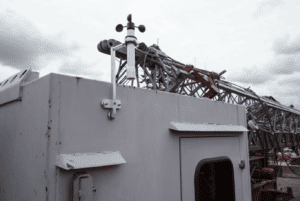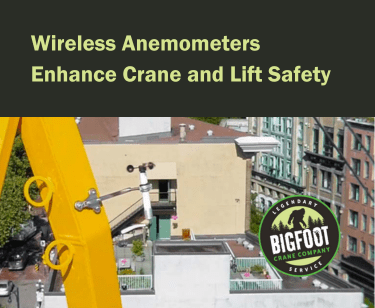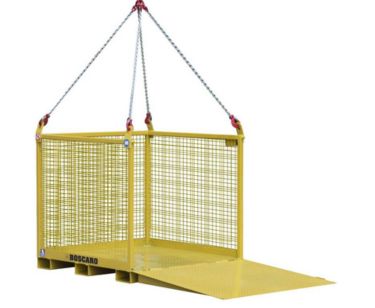The integration of technology like wireless anemometers has been a game-changer, significantly enhancing safety measures. Bigfoot Crane Company offers a variety of wireless anemometer models, each designed to meet specific needs in the construction industry.

Understanding Wireless Anemometers
Wireless wind anemometers are pivotal instruments in construction, especially for operations involving cranes and lifts. These devices, through advanced technology, provide crucial data on wind conditions that can be the difference between safe operations and hazardous incidents.
- Technology Behind Wireless Anemometers: These devices use state-of-the-art sensors to measure wind speed and direction. Unlike traditional anemometers, which require physical connections, wireless models transmit data via radio frequencies or Bluetooth, allowing for real-time monitoring from a safe distance.
- Components and Functionality: A typical wireless anemometer consists of wind speed sensors (often cup or vane types), a transmission unit, and a receiving interface, which is often a smartphone or a dedicated monitor. They are designed to be lightweight and durable, capable of withstanding harsh weather conditions prevalent on construction sites.
- Data Accuracy and Transmission: Precision is key in wind measurement. Wireless anemometers are often finely calibrated and can provide accurate readings even in low wind speeds. The transmission of data is almost instantaneous, ensuring that site managers and crane operators have up-to-date information.
- Ease of Installation and Use: One of the significant advantages of wireless anemometers is their ease of installation. They can be mounted directly on cranes or other areas of a construction site without complex wiring or setup procedures. Their user-friendly interfaces make it easy for operators to read and interpret the wind data.
The Critical Role of Wind Monitoring
Wind monitoring is not just a precautionary measure; it is a fundamental aspect of ensuring safety in crane and lift operations. The role of wind monitoring can be broken down as follows:
- Understanding Wind Dynamics: Construction sites, especially at higher elevations, are subject to varying wind conditions. Gusts can be unpredictable and change rapidly. Continuous wind monitoring helps in understanding these patterns and preparing accordingly.
- Crane Operation Decisions: Cranes are highly susceptible to accidents in high winds. Operators use data from anemometers to decide whether conditions are safe for lifts. This decision-making process is critical in preventing accidents and ensuring the safety of workers and materials.
- Planning and Efficiency: Accurate wind data aids in planning. Operations can be scheduled during times of lower wind speeds, thereby improving efficiency and reducing downtime caused by unsuitable weather conditions.
- Compliance with Safety Regulations: Many regions have strict safety regulations regarding crane operations, where specific wind speeds dictate operational limits. Anemometers ensure compliance with these regulations, avoiding potential legal issues and ensuring a safe working environment.
- Emergency Preparedness: In case of sudden weather changes, real-time wind data allows for swift action, such as securing crane loads or evacuating personnel, thereby mitigating potential hazards.
Wireless wind anemometers are not just technological tools; they are essential components of modern construction safety protocols. Their ability to provide real-time, accurate wind data is invaluable in ensuring the safety and efficiency of crane operations on construction sites.
Diverse Anemometer Models from Bigfoot Crane Company
Bigfoot Crane Company offers several wireless anemometer models, each with unique features:
- NAVIS W410XB/BAT and W410X Series Wireless Anemometer: Known for its long-range capabilities (up to 1.3 km), this model is ideal for large construction sites. It features alarm and pre-alarm warning lights and a back-lit graphic LCD.
- WINDY Smartphone Anemometer: This model offers a range of up to 100 meters and data refresh every 2 seconds. It’s user-friendly, connecting directly to smartphones and tablets.
- WINDY WR3-B Wireless Anemometer: Featuring a shock-resistant display unit with large, illuminated LCD ensures excellent visibility, and is ideal for sites where smartphone use is restricted or when you are not able to use your smartphone display.
- NAVIS WL 12 X Data Logging Anemometer: This device wirelessly transmits real-time wind and temperature data to a display unit which features data history running up to 168 consecutive hours stored on exchangeable SD cards.
Benefits of Wireless Anemometers in Construction
- Enhanced Real-Time Decision Making: Immediate wind data allows for rapid responses to changing conditions.
- Increased Accuracy and Reliability: These devices provide precise readings, essential for safe crane operations.
- Increased Safety and Cost Savings: Preventing accidents through improved safety measures leads to significant long-term cost reductions.
Integration with Safety Protocols
Using wireless anemometers with existing safety protocols on construction sites is a big help for keeping workers safe and making sure everything runs smoothly. These devices work with other safety measures like alarms, automatic machine turn-offs and hazard notification, providing a critical layer of real-time environmental monitoring. By knowing the wind conditions, workers can plan better, use equipment safely, and follow safety rules. It’s a smart way to use technology to make sure everyone stays safe on the job.
Practical Applications and Case Studies
Phoenix Fabricators and Erectors faced a challenging project: adding a 40-foot extension to a 100-foot water tank. Despite their 30 years of experience, the project was far from routine due to limited site space, proximity to a high school, and the critical factor of wind on lift day. After extensive planning, the key to success was the Navis WSM W410 X/B/M wind measurement system. It provided reliable, real-time wind data, crucial for lift day decisions. The system’s ease of use and smartphone app allowed for constant monitoring of onsite weather conditions. This technology proved vital in ensuring the safe and efficient completion of the project, which was accomplished in less than seven hours.
The Importance of Choosing the Right Model
Picking the right gear from Bigfoot Crane Company is key because it’s got to match up with what your site and project – whether it’s a sprawling space, the kind of weather that rolls through, or how much you’re relying on cranes. Getting this choice right means you’re setting up for success, keeping things safe, and running smoothly by staying on top of the sudden weather changes , all tailored to what your project really needs.
Conclusion
Wireless anemometers like those offered by Bigfoot Crane Company are not just tools but essential safety enhancers in the construction industry. By providing accurate and real-time wind data, they play a crucial role in ensuring the safety and efficiency of crane operations.
If you’re in the construction industry and have not yet considered the benefits of wireless anemometers, now is the time to explore. Check out Bigfoot Crane Company’s range of anemometers to find the one that fits your needs. Contact us for more information or to schedule a consultation.





